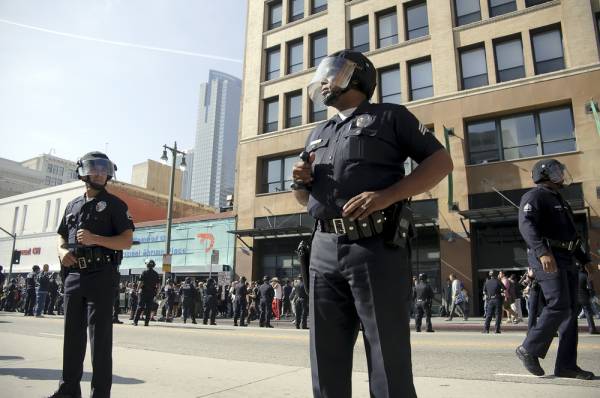The Thin Blue Line is an important symbol in law enforcement. It represents the men and women of law enforcement who stand together and are vastly outnumbered. The Thin Blue Line stands to honor all the men and women who have made the ultimate sacrifice in the line of duty. It represents the brotherhood of law enforcement, and reminds officers that we all rely on each other for backup to make it home safe.
The blue line is thin and constantly assaulted. Therefore it must be strong.
Why Strength Matters
For the Thin Blue Line to be strong, the brothers and sisters who make up that line must train to acquire strength. An officer who is strong is better suited to meet the physical demands of the job. Officers will find that getting stronger improves both tangible aspects of the job, like being more effective in subject control and use of force incidents, and intangible aspects of the job, like having more confidence and command presence.
Training to increase muscular strength will also help officers prevent injuries by better supporting the skeleton and joints. I have found that learning proper form in lifts, such as the squat and deadlift, promotes better posture and movement patterns. Officers spend many hours seated in cruisers, wearing Kevlar vests and duty belts, and as a result can become adapted to inefficient movement patterns and bad posture. Strength training can help correct these issues.
Most officers work out, but do not train with the specific goal of increasing strength. The majority of officers I have talked with work out regularly to stay fit and achieve aesthetic goals. Because of the popularity of bodybuilding, strength training has been relegated to a back corner of the weight room reserved for powerlifters and competitive athletes. Many officers have not received formal strength training instruction, and get the majority of their fitness information from popular muscle magazines and websites that promote eating, training, and taking supplements – like bodybuilders.
Law Enforcement Is Not Bodybuilding
Training like a bodybuilder is inefficient for meeting the physical demands of police work. Bodybuilders primarily train muscles individually to achieve aesthetic goals. Competitive bodybuilding has no athletic component to it requiring the application of full-body strength.
Competitive bodybuilders are impressive physical specimens with a tremendous amount of discipline, but they are not required to put their strength to the test. A bodybuilder’s goal is to grow larger and more appealing muscles, cut body fat as low as possible, and pose on stage. An officer who trains like a bodybuilder will look impressive in a uniform and increase command presence. However, an officer that trains with strength as the primary goal will be more effective at applying strength on the job.

When to Begin Training Strength
The perfect time to teach police officers about strength training is in the police academy. I imagine there are progressive police academies that have a basic barbell strength-training program as part of the academy curriculum. However, the majority of police academies focus physical training sessions on the exercises that cadets are required to pass on the physical agility test.
I don’t fault academies for this, as it is their responsibility to prepare cadets for the test within the limited time the have. However, police academies are also responsible for teaching cadets to establish habits that will help them have a successful career in law enforcement. I believe that embracing strength training as a primary form of physical training is one such habit.
Many academies break academy classes into smaller groups of cadets for training hands-on courses, such as defensive tactics and firearms instruction on the range. This would be an effective way for introducing strength training. An academy strength-training program should focus on teaching proper form in the squat, deadlift, overhead press, bench press, barbell row, and power clean. This could be accomplished in six hour-long sessions, one for each lift.
Cadets could then be introduced to beginner strength training programs such as a 3×5 or 5×5 with linear progression, in a classroom setting, and instructed to train as homework for the academy. Cadets could then return to the weight room weekly or biweekly to have their form and progress reviewed on all lifts.
Goals for Law Enforcement Officers
Setting and achieving goals and personal records is an important part of strength training. I believe by the end of the academy male cadets should be encouraged to reach:
- Bodyweight barbell back squat
- ¾ bodyweight bench press
- ½ bodyweight overhead press
- 1.25 bodyweight deadlift
An untrained cadet should be able to reach these strength levels over the course of a fifteen to twenty week academy. Cadets should be encouraged to set the following long-term career goals:
- Double bodyweight squat
- Bodyweight overhead press
- 2.5 bodyweight deadlift
- 1.5 bodyweight bench press

These strength levels will make officers stronger than 99% of the people they encounter on the job. An officer can achieve these goals with a few years of dedicated strength training, with three or four training sessions per week. Once these strength levels are reached, an officer can maintain them with just one or two training sessions a week.
In order to convince cadets to establish long-term strength training habits, the program must challenge cadets to achieve a personal record (PR) in at least one lift. The academy’s on-staff strength training coach should help each cadet decide which lift they excel the most at, and encourage them to set a personal record in that lift at some point during the academy. The reward of hitting a PR for the first time is the best way to convince a cadet to adopt a career of strength training.
You Can Make a Difference
Stronger officers are more effective on the job and less likely to get injured. Officers taught to train for strength would be a benefit to citizens, departments, and other officers.
You can help make the Thin Blue Line stronger:
- If you are a citizen, forward this article to a police officer.
- If you are an officer, pass this on to an academy instructor.
- If you instruct in the academy, show your academy commander this article.
- If you are an academy commander, talk to your state’s regulating Peace Officer Training Commission about changing the curriculum and seek the funding necessary to get a strength coach on staff and a full weight room.
Photos courtesy of Shutterstock.






